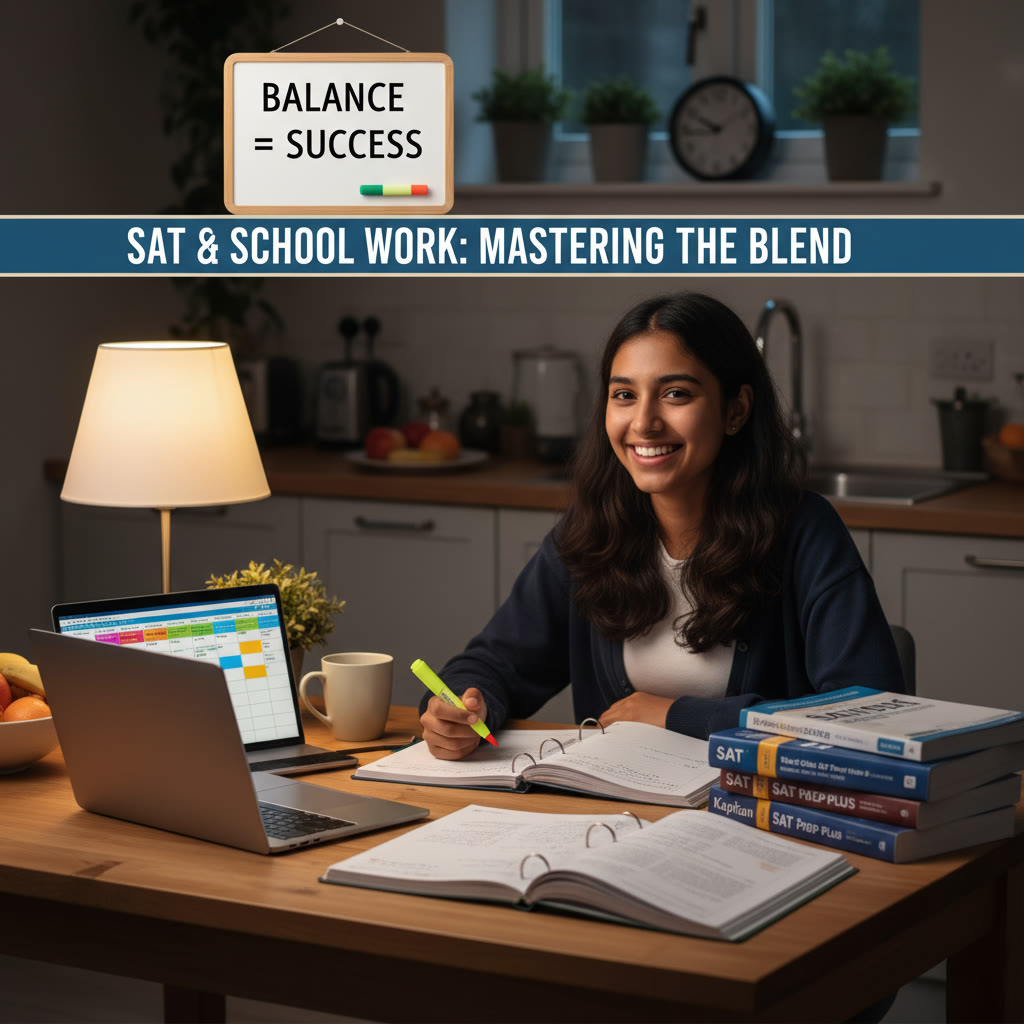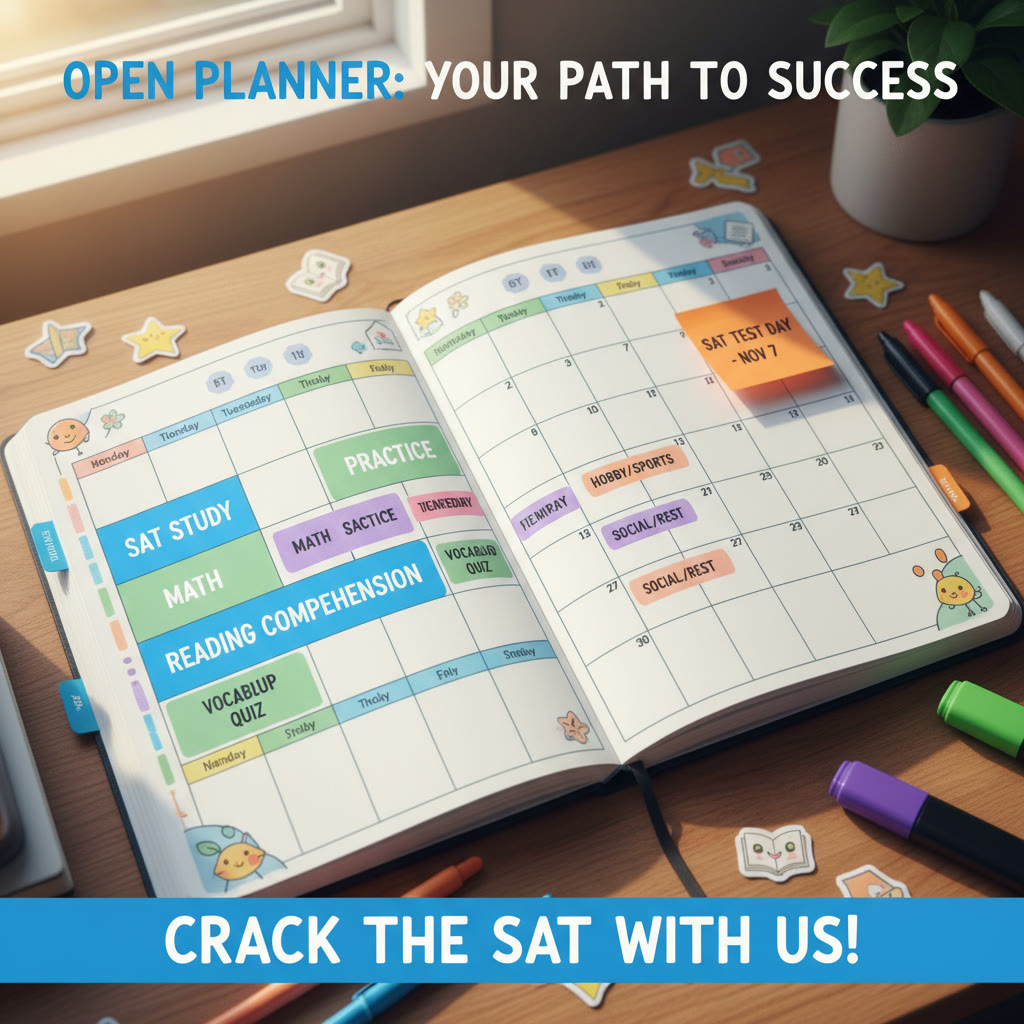How to Balance SAT Prep With School Exams
There are only so many hours in a day, and between classes, homework, extracurriculars and family time it can feel impossible to add SAT prep to the mix. But with a little planning, smarter study techniques and the right support, you can make steady SAT progress without burning out during midterms or finals. This post walks through realistic schedules, evidence-based study methods, a sample weekly plan, and a short multi-week roadmap you can adapt. I’ll also point out how Sparkl’s personalized tutoring and insights can naturally fit into your plan if you want extra guidance.

Why balancing matters: the mindset behind the schedule
First, a quick mindset shift: balancing doesn’t mean giving equal time to everything. It means distributing your effort where it has the most impact. A focused 45-minute SAT session of deliberate practice can beat three distracted hours staring at flashcards. The goal is sustainable momentum—small wins that build confidence without derailing your school performance.
Quality over quantity
When you’re juggling everything, focus on high-return activities: targeted practice on weak areas, full-length exams with detailed review, and short, intense review sessions instead of marathon cramming. This approach preserves energy for school exams while keeping SAT progress visible.
Start by mapping the calendar
Open your calendar and mark three types of dates: school exams (quizzes, midterms, finals), fixed school obligations (presentations, lab days), and SAT target dates. Once you can see conflicts on one page, planning becomes a lot easier.
Important things to include
- School test windows and project deadlines
- SAT registration deadlines and test dates you’re considering
- Practice test dates (schedule them like appointments)
- Recovery days—non-negotiable rest or social time
Example: a junior-year fall overlap
Imagine you have midterms in early November and want to take the SAT in December. The practical move is to use October for diagnostic tests and targeted weak-point work, then shift to maintenance in November so school midterms get your top energy. December ramps back up two weeks before the test for focused practice tests and strategy reviews.
Build a flexible weekly routine
A flexible routine is your best friend. Use time-blocking for the week, not the day—this allows you to move sessions around without guilt. Treat SAT prep as an appointment: write it on the calendar and honor it like a class.
Time blocks that make sense
- Short focused sessions (30–50 minutes) for skill work: math topics or grammar rules.
- One longer session (90–180 minutes) weekly for a full practice section or practice test review.
- Daily 10–15 minute warm-ups on test-day skills (vocab used in context, mental math drills).
The Pomodoro and the 90-minute rule
Pomodoro (25 minutes focused + 5 minutes break) works well for homework bursts and for review drills. For deeper conceptual work—like untangling a complex math topic—use 90-minute focus blocks where your brain gets into a flow state. Mix both depending on the task.
Sample weekly schedule
This sample week is for a student with normal school hours, two hours of evening homework, and a goal of 6–8 hours of SAT prep per week. Adjust the times to suit your day.
| Day | School / Classes | Homework / Study | SAT Prep | Rest / Activities |
|---|---|---|---|---|
| Monday | 8am–3pm | 4:00–6:00pm | 6:30–7:15pm (vocab + quick math drill) | 7:15–9:00pm dinner / club |
| Tuesday | 8am–3pm | 4:00–6:00pm | 6:30–8:00pm (focused 90-min math topic) | 8:00–10:00pm family time / sleep prep |
| Wednesday | 8am–3pm | 4:00–6:00pm | 6:30–7:10pm (reading comprehension drill) | 7:15–9:00pm sports / downtime |
| Thursday | 8am–3pm | 4:00–6:00pm | 6:30–8:30pm (practice section + review) | 8:30–10:00pm light reading / sleep |
| Friday | 8am–1pm (early end) | 2:00–4:00pm | 4:30–5:00pm (light warm-up) | Evening off—social / rest |
| Saturday | Optional extracurriculars | 11:00–1:00pm (catch-up) | 2:00–5:00pm (full practice section or timed test) | Evening family / friends |
| Sunday | Relax / chores | 4:00–5:00pm (review errors from Saturday) | 6:00–7:00pm (light review / plan week) | Rest and sleep early |
This schedule prioritizes one heavy practice session (weekend) and short daily work to keep skills fresh. During school exam weeks, switch weekend practice to shorter maintenance sessions and move the heavy sessions after exams.
Study strategies that save time
When you’re pressed for time, technique matters more than hours. Here are evidence-based methods that give the best return for the effort.
Active recall and spaced repetition
- Active recall: close the book and reproduce an idea from memory. It’s more effective than re-reading.
- Spaced repetition: review topics at increasing intervals. Use short reviews between school subjects—two minutes of recall beats 20 minutes of passive reading.
Targeted practice instead of blind practice
After a practice test, don’t just re-do problems you got right. Focus on the mistakes and the types of questions that consistently trip you up. Make an error log—note the misconception, the correct approach, and a short trigger phrase to remind you.
High-frequency drills
For math, practice sets of similar problems to build speed and pattern recognition. For reading, do short passages with a goal—main idea, inference, or evidence-based question. Rotate types so you don’t over-focus on one skill at the expense of others.
When exams overlap: two-week taper and triage
If your midterms fall two weeks before an SAT you planned for, you’ll need triage. The good news: a small, strategic change keeps you protected on both fronts.
Two-week taper strategy
- Week -2 (two weeks before school exams): Maintain normal school study schedule; keep SAT to 30–60 minutes daily of low-effort maintenance (warm-ups, error-log review).
- Week -1 (exam week): Reduce SAT to 15–30 minute low-pressure sessions—focus on confidence and sleep. Use light review only.
- After school exams: Take two days to recover, then resume focused SAT practice, starting with a timed section to rebuild rhythm.
Prioritize—what to cut and what to keep
When time is tight, ask: which activities most directly affect test scores? Keep these:
- One weekly timed section or practice test (even if shortened to half a test)
- Immediate review of errors
- Short daily active recall sessions
Cut or postpone lower-impact tasks like full-length vocabulary lists or generalized review that doesn’t target your weaknesses.
Balancing energy, not just time
Time is a limited resource, but energy is the currency that makes study effective. Small habits amplify energy: consistent sleep, hydration, movement, and micro-breaks.
Sleep and recovery
Even one late night can significantly reduce focus the next day. During heavy weeks, prioritize sleep—an extra hour of sleep almost always beats an extra hour of late-night study in terms of retention and mood.
Short aerobic breaks and nutrition
Do light exercise—10–20 minutes of walking or jumping rope—between study blocks to reset. Eat balanced meals with protein and complex carbs before big study sessions. Keep a water bottle nearby.
Mental resets
When anxiety spikes, use a 5-minute breathing routine: box breathing (4-4-4-4) or 4-4-8. These quick resets reduce cognitive load better than scrolling social media.
Real-world example: Maya’s semester
Maya is a 11th grader taking AP Biology and Algebra II, captain of the soccer team, and planning for a December SAT. She’s worried about midterms in early November. Here’s how she balanced everything in a realistic way:
- September: Diagnostic test, booked three weekend practice sections, started an error log. Two short evening sessions per week (30–45 minutes).
- October: Focused on weakest math topics in two 90-minute sessions each week. Short daily 10-minute reading warm-ups. Cut club obligations two weeks before midterms.
- Early November (midterms): SAT work reduced to 15–20 minute warm-ups and reviewing major errors. She slept more and reduced weekend practices to one light session.
- Post-midterms (mid-November): Two days off, then three weeks of focused SAT practice in the evenings and a full-length practice test every other weekend. December SAT day arrived with energy and confidence.
Maya found that being ruthless about what she cut (club prep she could share, volunteering swaps, and social media time) gave her a lot more breathing room without sacrificing her school grades.
Tools and supports that speed progress
You don’t have to do this alone. Smart supports make study more efficient and reduce worry—especially when you’re balancing multiple priorities.
When to consider 1-on-1 help
- If you hit a stubborn plateau after several weeks of practice
- If scheduling conflicts mean you waste time guessing what to study
- If you want a tailored plan that fits around specific school exam dates
Sparkl’s personalized tutoring can be especially helpful here: expert tutors who create tailored study plans, 1-on-1 guidance that targets your weak spots, and AI-driven insights that highlight progress and areas to focus on. With clear checkpoints and a coach to keep you accountable, the overlap between school exams and SAT prep becomes manageable rather than overwhelming.
Study tools to use
- An error log (paper or digital) to track and categorize mistakes
- Timed practice tests scheduled on the calendar like an exam
- Flashcards or spaced-repetition apps for vocabulary and formulas
- A simple planner to block out study times and recovery

Eight-week ramp: a simple roadmap
This is a flexible eight-week plan if you’re balancing school exams and preparing for an SAT about two months away. Adjust intensities during exam weeks.
- Week 1: Diagnostic. Take a timed practice test. Make an error log. Set three primary skill goals (e.g., algebra, sentence structure, passage inference).
- Week 2: Targeted work. One 90-minute focus on the hardest topic, short daily warm-ups, and one practice section at the weekend.
- Week 3: Consolidation. Drill weak areas, start mixed practice sets, and track timing strategy.
- Week 4: School exam window—taper SAT work to maintenance (short reviews and light practice tests), prioritize sleep and school exam prep.
- Week 5: Recovery week—two days rest, then resume with a full-length practice test, analyze errors in detail.
- Week 6: Strategy week—refine timing, practice skipping and returning to questions, build pacing plans.
- Week 7: Peak practice—two full practice tests (one timed, one diagnostic-style), review every error, sharpen essay strategy if applicable.
- Week 8: Final taper—light targeted practice, solid sleep routine, plan logistics for test day (documents, travel, food).
Final checklist before a busy week
- Mark every exam on the calendar and block time for study
- Schedule one fixed SAT appointment per week (practice test or long section)
- Keep a daily 15–30 minute SAT maintenance slot during exam-heavy weeks
- Create an error log and review it weekly
- Prioritize sleep and short exercise breaks
- Ask for targeted help when a concept stalls you—1-on-1 tutoring saves weeks of confusion
Closing: stay flexible and kind to yourself
Balancing SAT prep with school exams is a learnable skill. If you treat SAT study like a part-time job with smart priorities and small daily rituals, you’ll keep moving forward while still rocking your schoolwork. Accept that some weeks will be heavy on school, others on SAT prep—what matters is the long arc. A consistent, adaptable plan beats perfection every time.
If you want help building a plan that fits your exact schedule or prefer one-on-one coaching during crunch times, consider reaching out to an expert tutor. Sparkl’s personalized tutoring offers tailored study plans, expert tutors who understand how to align SAT prep with your school calendar, and AI-driven insights that help you focus only on what moves your score. With a little structure and the right supports, you can walk into test day calm, prepared and ready to perform.
Good luck—plan smart, rest well, and keep steady. You’ve got this.



















No Comments
Leave a comment Cancel